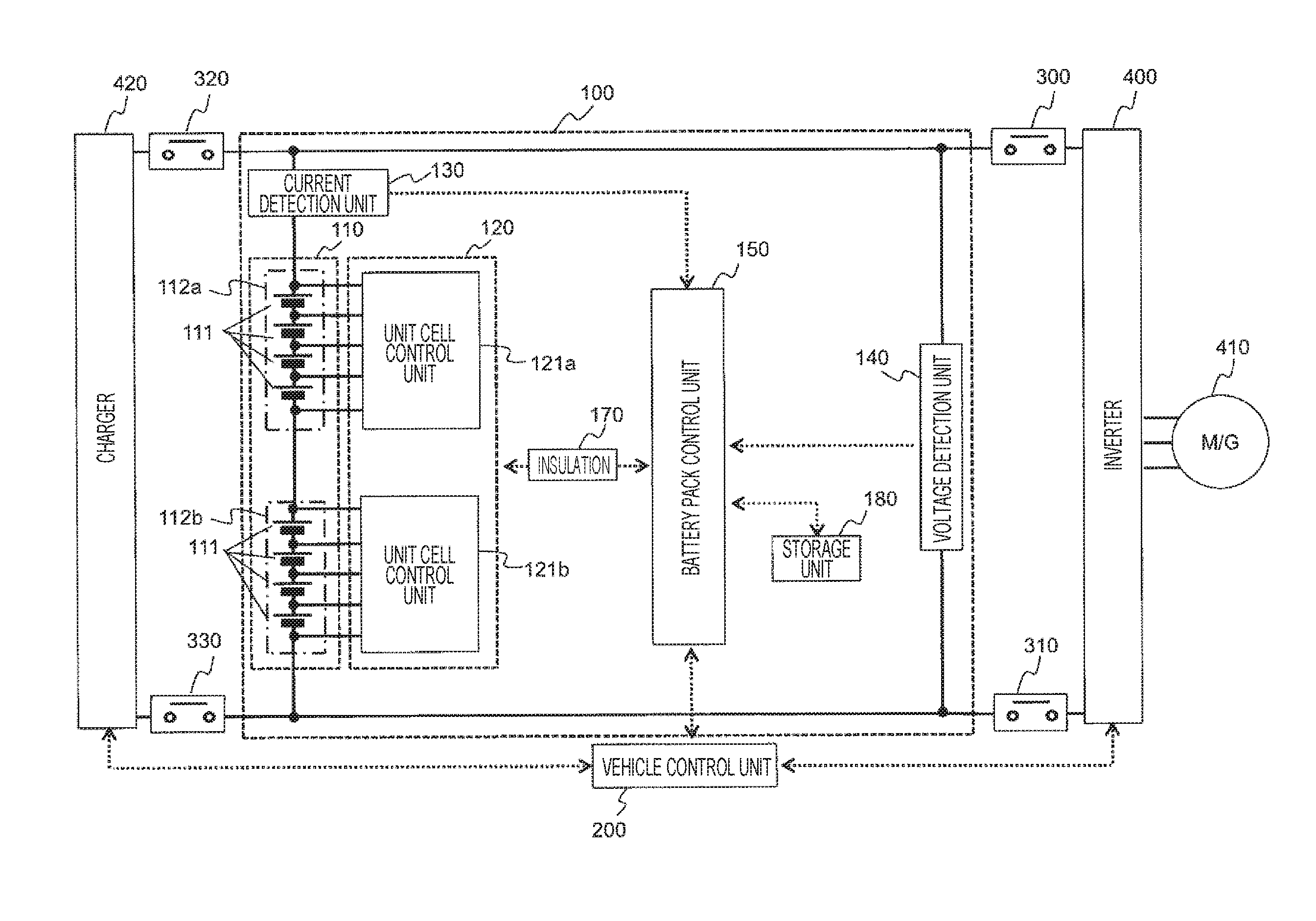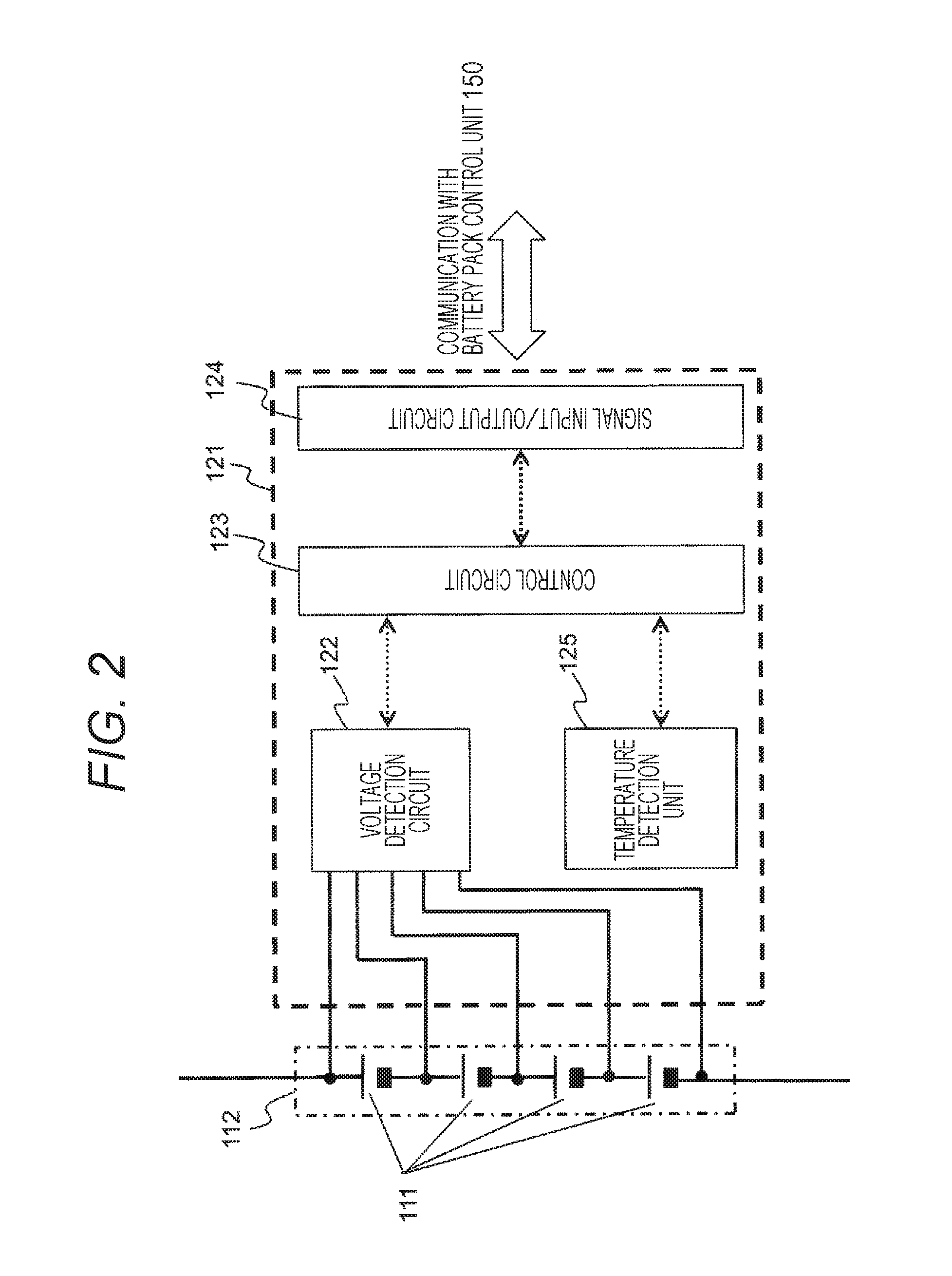Secondary Battery System
a battery system and secondary battery technology, applied in batteries, hybrid vehicles, instruments, etc., can solve the problem of increasing the error of the so
- Summary
- Abstract
- Description
- Claims
- Application Information
AI Technical Summary
Benefits of technology
Problems solved by technology
Method used
Image
Examples
first embodiment
[0025]In a first embodiment, there will be described a case where the present invention is applied to a secondary battery system that is mounted in a vehicle system included in a hybrid vehicle (HEV), a plug-in hybrid vehicle (PHEV) and an electric vehicle (EV).
[0026]FIG. 1 is a diagram illustrating the configuration of a secondary battery system 100 and its periphery according to the first embodiment. The secondary battery system 100 is connected to an inverter 400 performing PWM control on a motor / generator 410 via relays 300 and 310. The secondary battery system 100 is also connected to a charger 420 via relays 320 and 330. A vehicle control unit 200 communicates with a battery pack control unit 150, the charger 420 and the inverter 400.
[0027]The secondary battery system 100 includes a battery pack 110, a unit cell management unit 120, a current detection unit 130, a voltage detection unit 140, the battery pack control unit 150, a storage unit 180, and an insulating element 170 t...
second embodiment
[0107]In a second embodiment, there will be described a case where the present invention is applied to a secondary battery system that is mounted in a vehicle system included in a hybrid vehicle (HEV) and a plug-in hybrid vehicle (PHEV). Note that a definition of each of a charging period and a discharging period is similar to that of the first embodiment. Moreover, a part similar to that of the first embodiment will not be described.
[0108]As has been described with reference to FIGS. 10(a1) to 10(b2), the present invention cannot be applied when only charging or discharging continues. Accordingly, when only charging or discharging continues in the second embodiment, a reverse charging or discharging operation is forcibly performed. Details will be described below.
[0109]FIG. 12 illustrates the flow of processing added to a battery pack control unit 150 in the second embodiment. The battery pack control unit 150 of the second embodiment monitors a charging / discharging status of a bat...
third embodiment
[0111]In a third embodiment, there will be described a case where the present invention is applied to a secondary battery system that is mounted in a vehicle system included in a hybrid vehicle (HEV), a plug-in hybrid vehicle (PHEV) and an electric vehicle (EV). Note that a definition of each of a charging period and a discharging period is similar to that of the first embodiment. Moreover, a part similar to that of the first embodiment will not be described.
[0112]Instead of detecting an SOCv from a CCV, a battery pack control unit 150 of the third embodiment estimates an OCV from the CCV and then detects the SOCv from the estimated OCV.
[0113]The OCV can be estimated by using expression (5) and an equivalent circuit model in FIG. 4. Note, however, that battery characteristics such as an internal resistance 114, an impedance 115 and a capacitance 116 need to be extracted from charge / discharge test data of a battery and stored in advance into a storage unit 180 as described above, so ...
PUM
| Property | Measurement | Unit |
|---|---|---|
| reduction | aaaaa | aaaaa |
| current | aaaaa | aaaaa |
| charge current | aaaaa | aaaaa |
Abstract
Description
Claims
Application Information
 Login to View More
Login to View More - R&D
- Intellectual Property
- Life Sciences
- Materials
- Tech Scout
- Unparalleled Data Quality
- Higher Quality Content
- 60% Fewer Hallucinations
Browse by: Latest US Patents, China's latest patents, Technical Efficacy Thesaurus, Application Domain, Technology Topic, Popular Technical Reports.
© 2025 PatSnap. All rights reserved.Legal|Privacy policy|Modern Slavery Act Transparency Statement|Sitemap|About US| Contact US: help@patsnap.com



